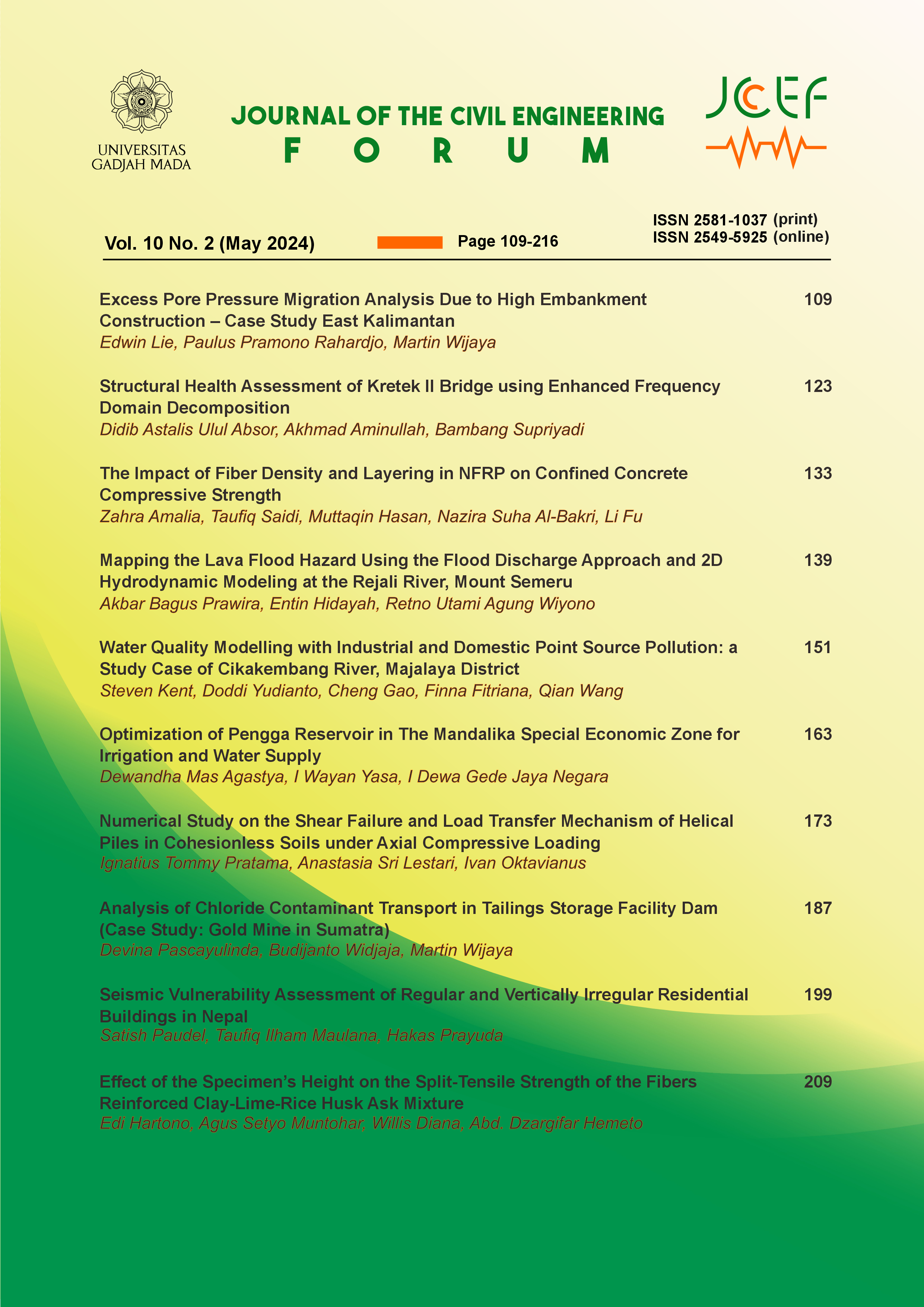The Impact of Fiber Density and Layering in NFRP on Confined Concrete Compressive Strength
Abstract
Strengthening columns holds a crucial role in structural engineering and is frequently called for due to a range of factors, including heightened load requirements, structural degradation, design flaws, or the need for seismic retrofitting. Natural Fiber-Reinforced Polymers (NFRP) in concrete reinforcement has gained significant attention in recent years as a sustainable and eco-friendly alternative to strengthened reinforced concrete. NFRP jacketing presents an adaptable option, as it delivers an improved load-carrying capability as a confining effect. This paper explores the fundamental reasons behind the need for column strengthening and the advantages of employing NFRP jacketing as a preferred method. The study examined the influence of varying fiber densities and the number of fiber layers in NFRP on the mechanical properties of concrete, with a specific focus on its confined concrete compressive strength. The test specimen was a cylinder with a diameter of 150mm and a height of 300mm. NFRP, made from abaca fiber and resin, was attached around the specimen’s circumference to provide a confinement effect. Axial load was applied to the test specimen. The findings indicated that introducing abaca fiber as an NFRP material increased confined concrete compressive strength by up to 37% compared to unconfined concrete. Moreover, the application of three layers of NFRP fibers results in a 15% rise in confined concrete stress, especially when higher-density fiber types are utilized. Study findings suggest that natural fiber density and the number of layers play a role in enhancing concrete strength, however, their influence may not be significantly pronounced.
References
Alam,M. A. and Al Riyami, K. (2018),‘Shear strengthening of the reinforced concrete beam using natural fiber reinforced polymer laminates’, Construction and Building Materials . URL: https://doi.org/10.1016/j.conbuildmat.2017.12.011
Balla, T. M. R., Suriya Prakash, S. and Rajagopal, A. (2023), ‘Role of size on the compression behaviour of hybrid FRP strengthened square rc columns – experimental and finite element studies’, Composite Structures 303,116314. URL: https://doi.org/10.1016/j.compstruct.2022.116314
Barros, J. A. O., Dias, S. J. E. and Lima, J. L. T. (2007), ‘Efficacy of CFRP-based techniques for the flexural and shear strengthening of concrete beams’, Cement and Concrete Composites . URL: https://doi.org/10.1016/j.cemconcomp.2006.09.001
Belarbi, A. and Acun, B. (2013), ‘Frp systems in shear strengthening of reinforced concrete structures’, Procedia Engineering 57, 2–8. URL: https://doi.org/10.1016/j.proeng.2013.04.004
Chen, C. et al. (2020), ‘Comparative analysis of natural fiber reinforced polymer and carbon fiber reinforced polymer in strengthening of reinforced concrete beams’, Journal of Cleaner Production 263, 121572. URL: https://doi.org/10.1016/j.jclepro.2020.121572
Grace, N. F. et al. (2000),‘Strengthening reinforced concrete beams using fiber reinforced polymer (FRP) laminates’, pp. 865–875.
Hussain, Q. et al. (2022), ‘Shear enhancement of rc beams using low-cost natural fiber rope reinforced polymer composites’, Buildings 12(602), 1–22. URL: https://doi.org/10.3390/buildings12050602
Jirawattanasomkul, T. et al. (2019), ‘Effect of natural fibre reinforced polymers on confined compressive strength of concrete’, Construction and Building Materials 223, 156–164. URL: https://doi.org/10.1016/j.conbuildmat.2019.06.217
Ku, H. et al. (2011), ‘A review on the tensile properties of natural fiber reinforced polymer composites’, Composites Part B: Engineering . URL: https://doi.org/10.1016/j.compositesb.2011.01.010
Mensah, C. et al. (2020), ‘Effect of different bond parameters on the mechanical properties of FRP and concrete interface.'
Nwankwo, C. O. and Ede, A. N. (2020), ‘Flexural strengthening of reinforced concrete beam using a natural fibre reinforced polymer laminate: an experimental and numerical study’,
Materials and Structures/Materiaux et Constructions 53(6). URL: https://doi.org/10.1617/s11527-020-01573-x
Rahman, A., Mallick, M. and Ghosh, S. (2018), ‘Experimental behavior of FRP confined concrete cylinder wrapped by two different frps’, 7(2), 18–25. URL: https://doi.org/10.5539/jmsr.v7n2p18
Rizkalla, S., Hassan, T. and Hassan, N. (2003), ‘Design recommendations for the use of FRP for reinforcement and strengthening of concrete structures’, Progress in Structural Engineering and Materials 5(1), 16–28. URL: https://doi.org/10.1002/pse.139
Saidi, T., Hasan, M. and Amalia, Z. (2022), ‘Tensile strength of natural fiber in different type of matrix’, Aceh International Journal of Science and Technology 11(2), 136–144. URL: https://doi.org/10.13170/aijst.11.2.26175
Saidi, T., Hasan, M. and Amalia, Z. (2023), ‘Preliminary study of NFRP-Confined concrete for enhancing compressive strength’, Aceh International Journal of Science and Technology 12(1), 79–86. URL: https://doi.org/10.13170/aijst.12.1.31500
Tong, F. S. et al. (2017),‘Natural fiber composites as potential external strengthening material – a review’, Indian Journal of Science and Technology . URL: https://doi.org/10.17485/ijst/2017/v10i2/110368
Wambua, P., Ivens, J. and Verpoest, I. (2003), ‘Natural fibres: Can they replace glass in fibre reinforced plastics?’, Composites Science and Technology 63(9), 1259–1264. URL: https://doi.org/10.1016/S0266-3538(03)00096-4
Wang, W. et al. (2020), ‘A comparative study of impact behaviour between natural flax and glass FRP confined concrete composites’, Construction and Building Materials 241, 117997. URL: https://doi.org/10.1016/j.conbuildmat.2020.117997
Yinh, S. et al. (2021), ‘Strengthening effect of natural fiber reinforced polymer composites (NFRP) on concrete’,Case Studies in Construction Materials 15, e00653. URL: https://doi.org/10.1016/j.cscm.2021.e00653
Copyright (c) 2024 The Author(s)

This work is licensed under a Creative Commons Attribution-ShareAlike 4.0 International License.
Copyright is granted to authors for the purpose of providing protection for articles written to describe experiments and their results. JCEF will protect and defend the work and reputation of the author and are also willing to address any allegations of violation, plagiarism, fraud, etc. against articles written and published by JCEF. JCEF is published under the terms of the Creative Commons Attribution-ShareAlike 4.0 International License (CC BY-SA 4.0). The author holds the copyright and assigns the journal rights to the first publication (online and print) of the work simultaneously.







